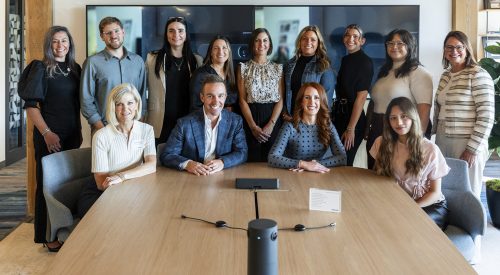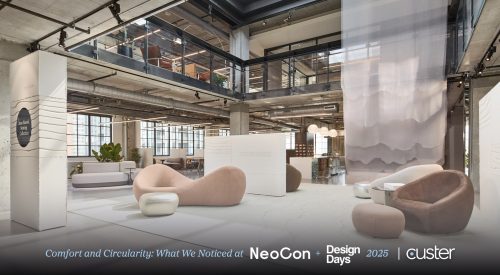- Blog
- The Great Return
How to Create Work Experiences to Bring People Back, Re-Engage, and Re-Energize
Nikki Nordfjord
on Jul 26, 2022
On July 13th, leaders in human resource and global real estate from top area businesses joined us at Custer for a roundtable discussion with Steelcase’s Vice President of Workplace Insights, Dr. Tracy Brower. The conversation centered around challenges, successes, and lessons we’re learning as we create work experiences that bring employees back to the office and re-connect them to a company’s culture, people, and purpose.
Guests included Michael Willerer, Director of Human Resources with Irwin Seating Company, Nate Nixon, HR Business Partner with Spartan Nash, Shaina Lane, HR Business Partner with Spartan Nash, Nick Dabowski, Senior Director of Global Real Estate with Kellogg’s, Alex Kutyreff, Director of Facilities with Kellogg’s, Amber Robke, HR Generalist with Attwood Corporation, and Danielle Smith, Head of People and Culture with Shape Corp.

Dr. Brower opened the conversation by inviting participants to identify one word that comes to mind when one thinks of the ‘future of work’ in the next five years. The responses shared a theme of either describing the attributes of the physical workspace or the emotions behind change that’s occurring in talent attraction and retention.
The dialog following this initial question fell into four subtopics of human resources insights, which we explored over the course of our time together.
Topic #1: The struggle of hiring and keeping talent in the current landscape.
We’re currently going through a significant talent revolution in the wake of the pandemic. It is a time when things done in the past to affect people and culture are not working anymore. We’re witnessing a power dynamic where there are more jobs than there are people, giving the talent more opportunity to be uncompromising in their demands of their employer.
Two respondents shared that in the hiring process, the real estate and environment are becoming a driver in attracting new talent. Alex Kutyreff, Director of Facilities at Kellogg, shared that global enhancements in their real estate portfolio were estimated to be saving over $100K in retention costs by investing in environments that are more pleasing to their employees.
Shaina Lane shared that she is seeing talent career development equating to “the new pension” for workers Spartan Nash is trying to hire. Applicants are thinking about their future, and they want to ensure there is an opportunity for advancement within the company. On this topic, Dr. Brower shared that LinkedIn found in a study of their own employees that when there was internal mobility within the company, retention went but up by 50%.
Topic #2: The challenge of creating equitable opportunities for hybrid work for all employees.
When it comes to the subject of flexibility and a hybrid work policy, it’s a question that all companies are having to tackle. The answer is not one size fits all, which presents a problem for those looking to other organizations for best practices. Setting rules that are too structured receives pushback no matter how lenient the policy may seem. Representatives from Kellogg’s noted that even before the pandemic, they instituted a ‘Locate for Your Day’ initiative, setting an expectation that 50% of time must be spent in the office while 50% of time could be worked remote. Post-pandemic, even though employees voluntarily would come into the office more than half the time, they don’t want to be told they have to do so.
Remote work policies become even more challenging when a majority of your workforce must be on site in order to perform their job function (i.e. manufacturing). There is the problem of equity in offering a flexible schedule for some while not providing that benefit to others. These decisions around hybrid benefits have a strong effect on company culture and employee engagement. Participant Michael Willer sited the challenge of losing staff to startups where they find they may have greater flexibility in their day-to-day work lives.
Topic #3: The opportunity to engage, or re-engage, current employees in their work.
The need to hook and hold current employees is as real as the challenge to hire incoming talent, but are workers too quick to jump given the research on job changes over the last year? Dr. Brower shared some interesting insights from a recent study to address this question.
40% of workers surveyed are planning to leave their employer in the next year.
43% of C-suite and HR professionals report needing to hire additional staff.
72% of workers who have left their job in the last year regret the move.
64% of those would go back to their old job if given the opportunity.
Nick Dabrowski of Kellogg’s used the analogy that, “HR is focused on playing offense for new talent and defense for their current employees” with engagement. There may be a lot of interest to explore the waters of the job pool, but the grass is not always greener on the other side. Salary, vacation, flexible hours might all be considerations in finding the right job fit, but how invested your employees are in company culture and their personal purpose is the key to holding on to strong talent.
Unfortunately, there is no data yet that would prove or disprove the hypothesis that if employees work from home, they are more likely to leave their company. But what we do know through research is that when people feel more connected to their organization, they’re more likely to stay with their organization.
Topic #4: The reality that individuals have reprioritized their values and refocused on overall wellbeing.
Nate Nixon of Spartan Nash addressed meaningful changes we’re all experiencing when it comes to work-life balance. In the past, there has been a clear separation of work-life and home-life. The lines between these two areas have been blurred and every working individual is looking at how one can support the other beyond our basic needs. Since dimensionality is important to our overall happiness, the more variety one has in their values and priorities, the more likely they are to be happy. Over the past two years, we have found ways to foster meaningful relationships within our personal lives, why should we not apply this intentionality to our working relationships as well?
Dr. Brower shared that 75% of those surveyed in a survey around engagement reported that they make friends in the workplace, proving that our connections to others is a crucial to our happiness at work.
Having addressed the challenges of people and place during this “great return” to the office, we concluded with asking how HR and real estate leaders plan to reconsider or reinvent the work experience. Responses included educating leaders on how to keep employees engaged, keeping employees connected to culture, creating new opportunities, and reidentifying the portfolio of real estate and how it’s working for talent.


